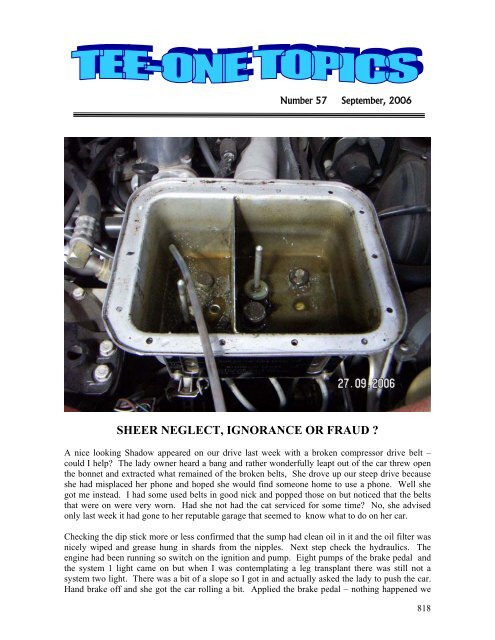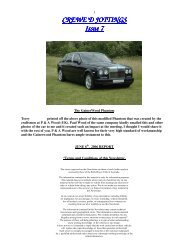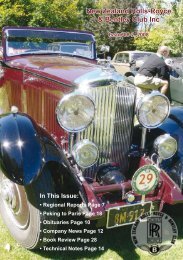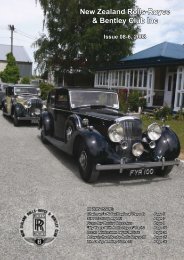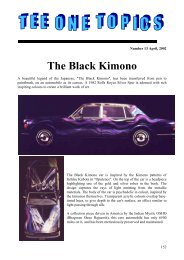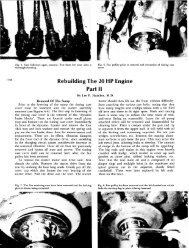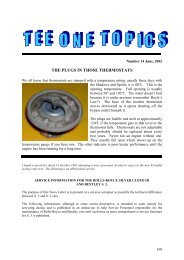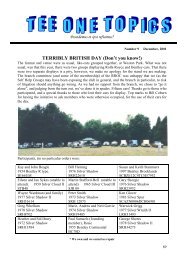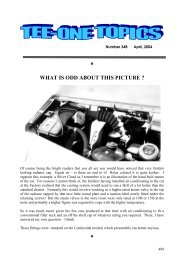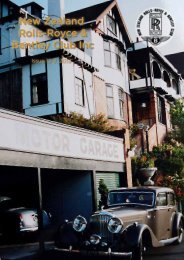sheer neglect, ignorance or fraud - Rolls-Royce Owners' Club of ...
sheer neglect, ignorance or fraud - Rolls-Royce Owners' Club of ...
sheer neglect, ignorance or fraud - Rolls-Royce Owners' Club of ...
Create successful ePaper yourself
Turn your PDF publications into a flip-book with our unique Google optimized e-Paper software.
Number 57 September, 2006<br />
SHEER NEGLECT, IGNORANCE OR FRAUD ?<br />
A nice looking Shadow appeared on our drive last week with a broken compress<strong>or</strong> drive belt –<br />
could I help? The lady owner heard a bang and rather wonderfully leapt out <strong>of</strong> the car threw open<br />
the bonnet and extracted what remained <strong>of</strong> the broken belts, She drove up our steep drive because<br />
she had misplaced her phone and hoped she would find someone home to use a phone. Well she<br />
got me instead. I had some used belts in good nick and popped those on but noticed that the belts<br />
that were on were very w<strong>or</strong>n. Had she not had the cat serviced f<strong>or</strong> some time? No, she advised<br />
only last week it had gone to her reputable garage that seemed to know what to do on her car.<br />
Checking the dip stick m<strong>or</strong>e <strong>or</strong> less confirmed that the sump had clean oil in it and the oil filter was<br />
nicely wiped and grease hung in shards from the nipples. Next step check the hydraulics. The<br />
engine had been running so switch on the ignition and pump. Eight pumps <strong>of</strong> the brake pedal and<br />
the system 1 light came on but when I was contemplating a leg transplant there was still not a<br />
system two light. There was a bit <strong>of</strong> a slope so I got in and actually asked the lady to push the car.<br />
Hand brake <strong>of</strong>f and she got the car rolling a bit. Applied the brake pedal – nothing happened we<br />
818
just kept rolling along as Paul Robeson would sing. No brakes. Started the engine – instant brakes<br />
– well the pumps at least w<strong>or</strong>k. Her daughter came to collect her and looked a bit dubious. I got<br />
them to stay while I pulled the top <strong>of</strong>f the reservoir since the sight glasses were quite black. The<br />
picture shows the mess that was revealed after I siphoned <strong>of</strong>f the murky liqu<strong>or</strong>s in the tank. At this<br />
stage the owner and daughter departed. I am glad she saw the evidence <strong>of</strong> simple <strong>neglect</strong>.<br />
I filled the reservoir after cleaning it and the sight glasses and the filters and ran about a litre <strong>of</strong><br />
brake fluid per bleed nipple out under full pressure in the hope that the detritus that must have got<br />
into the system would be flushed out. I earthed the pressure switch wire and the light came on so<br />
<strong>of</strong>f with the switch, a kit inserted a quick pressure test on the nitrogen cylinder refit and all the<br />
lights are a blinkin!<br />
Next step was to carefully<br />
unscrew the accumulat<strong>or</strong><br />
charging screw caps which on<br />
a Shadow I you can do, unlike<br />
its immediate success<strong>or</strong>.<br />
Prising out the plastic sealing<br />
balls there was no squirt <strong>of</strong> gas<br />
so at least the charging valves<br />
were sealing.<br />
In the number 1 section at left a<br />
collapsed filter near the top <strong>of</strong> the<br />
compartment as we look at it is<br />
almost submerged in muck. How<br />
the pumps survived was a<br />
mystery<br />
Most imp<strong>or</strong>tantly there was no<br />
brake fluid so the diaphragms<br />
were still intact. I carefully screwed the charging hose on to the bottom <strong>of</strong> the number one<br />
accumulat<strong>or</strong>, and knowing that there was no hydraulic pressure in the sphere I slowly squirted in<br />
nitrogen until the gauge was a little over 7000 kilopascals (about 1000psi). Quickly releasing the<br />
pressure and unscrewing the hose I whacked on the cap with a new plastic sealing ball and screwed<br />
it home firmly.<br />
The lady came back that day and drove away with old but good belts and a fully operating hydraulic<br />
system. Took about 6 hours but then I am slow at these things. Why was that so difficult?<br />
<br />
FITTING A TYRE IS NOT DIFFICULT<br />
If you have the right equipment that is. F<strong>or</strong> those <strong>of</strong> you<br />
who have watched, the man usually grabs what appears to<br />
be a dish mop and slops something around the rim <strong>of</strong> your<br />
new, about to be installed tyre. The slop is soap solution<br />
quite harmless to rubber and a good temp<strong>or</strong>ary lubricant<br />
drying to nothing. Clearly in this case it didn’t happen.<br />
The big finger on the tyre mounter wiping around the dry<br />
rubber ring finally peeled some covering <strong>of</strong>f and<br />
eventually destroyed the seal <strong>of</strong> the tyre bead. Didn’t<br />
leak to start with, but left sitting the tyre would deflate in 48 hours. An expensive mistake.<br />
<br />
819
WHAT IS UNUSUAL ABOUT THIS<br />
SPEEDOMETER?<br />
I suppose without seeing the rear <strong>of</strong> the instrument<br />
you could be excused f<strong>or</strong> guessing it belonged to a T2<br />
Bentley. Actually it is designed f<strong>or</strong> an S3. They are as<br />
rare as rocking h<strong>or</strong>se manure. They drop straight into<br />
the dashboard and avoid you having to do sums as you<br />
drive along the road.<br />
Now if only I could find one f<strong>or</strong> my S2. The latter<br />
were <strong>of</strong> course the last cars to have the dial where the<br />
needle sat on nought at about 2.00 o’clock. The the<strong>or</strong>y<br />
was that as the needle spends most <strong>of</strong> its w<strong>or</strong>king life<br />
between nought and a hundred and twenty then leave<br />
gravity to do most <strong>of</strong> the w<strong>or</strong>k. But like many<br />
innovations someone thought a driver might get confused so the conventional zero at 7.00 o’clock<br />
prevailed!<br />
<br />
WHO HASN’T<br />
GOTA SET OF<br />
THESE?<br />
Having only a little garage<br />
(7.4 x 14.2 M) I always<br />
have to think carefully<br />
which car I should put<br />
where so that a ‘goer’ is not<br />
jammed in by a ‘non goer’.<br />
These trolley jacks were the<br />
answer to my prayer. About<br />
$99 a pair they slip under<br />
the wheels and with a bit <strong>of</strong><br />
a grunt a 2 ½ ton car can be<br />
moved in any direction you<br />
want.<br />
LOBRO JOINTS<br />
Ever wondered what they look like? Most<br />
applications are on front wheel drive shafts<br />
which allow the wheel to swivel while the<br />
drive is transmitted. The Fact<strong>or</strong>y finally<br />
decided early in the Sprit run that these were<br />
the answer to the rear drive shafts connecting<br />
to the rear stub axles. About the only<br />
maintenance is occasional repacking the joint<br />
with grease and renewing the dust covers.<br />
820
DECARBONISING THE EASY WAY<br />
Back in the last century when I was lad a neighbour bought a new 1949 F<strong>or</strong>d Custom. At the time<br />
new cars were a source <strong>of</strong> great wonder, with waiting lists running into years. The Holden was a<br />
year old and already tales abounded <strong>of</strong> all the things that could go wrong with that brave new<br />
venture. My favourite one was the rear do<strong>or</strong>s popping open if you dared tow anything heavy with<br />
the car, presumably strewing passengers all over the road as you sped along! The F<strong>or</strong>d by today’s<br />
standards was a pretty Spartan production but with a big side valve vee eight, a decent wheelbase<br />
and a bit <strong>of</strong> weight it was a pretty nifty conveyance.<br />
The owner <strong>of</strong> the F<strong>or</strong>d was a very fussy about the car and one thing that really bothered him was<br />
pinking which we know as pre-ignition. It was caused by po<strong>or</strong> fuel and all cars suffered<br />
acc<strong>or</strong>dingly. One side effect was to seriously carbon up the combustion chambers and if you got<br />
10,000 miles out <strong>of</strong> a set <strong>of</strong> plugs you were doing well. Plug cleaning was an accepted prophylaxis<br />
f<strong>or</strong> most owners! But removing the carbon build up from the combustion chambers was another<br />
thing. There were various home remedies and patented gadgets to do the job included water<br />
injection which rep<strong>or</strong>tedly loosened the carbon allowing it to be blown out the exhaust valve. My<br />
father’s 1948 Chevrolet with overhead valves posed a fair amount <strong>of</strong> w<strong>or</strong>k to decarbonise until<br />
another trick was employed – burning the carbon out. This involved bringing the piston to top dead<br />
centre poking in a petrol soaked small piece <strong>of</strong> rag into the spark plug hole then hosing in pure<br />
compressed nitrogen to excite the flame. The carbon would get so hot it was burn and blow back<br />
out <strong>of</strong> the plug hole. I never did see the result with the head <strong>of</strong>f.. As to the F<strong>or</strong>d, being a side valve<br />
engine whipping the heads <strong>of</strong>f was about as easy as changing the wheels. So the owner, every 1000<br />
miles used to have this done to keep his engine running sweetly.<br />
821
With the improvement in fuels the carbonning up problem was gradually f<strong>or</strong>gotten until today most<br />
engines it seems are not opened up until they need a complete overhaul. But carbon still builds<br />
particularly around valve stems and rings and in the past few years various chemical brews have<br />
been developed that can be fed into the fuel system which in turn cleans out the muck. Most <strong>of</strong><br />
these concoctions are designed to be fed into fuel injection systems which also benefit from the<br />
cleansing. Carburetted cars however being relics it seems <strong>of</strong> the past have been largely ign<strong>or</strong>ed.<br />
A friend shared his method <strong>of</strong> overcoming this discrimination particularly with the vee eights <strong>of</strong> our<br />
cars. His technique is to start with a hot engine and arrange to tap into the main air intake. The<br />
adapter on top <strong>of</strong> the air h<strong>or</strong>n is ideal. Remove it, turn it around and feed the cleaner through this<br />
aperture having made up a suitable adapter. To create sufficient suction a crude ‘choke’ is placed<br />
over the intake which is closed down until there is enough ‘suck’ to draw in the cleaner. But first<br />
the engine is treated to a good dose <strong>of</strong> diesel fuel which s<strong>of</strong>tens the carbon about half a litre should<br />
be ample. Warn the neighbours that you are not conducting self immolation demonstrations since<br />
the amount <strong>of</strong> smoke generated during this exercise is considerable.<br />
The diesel is followed up by the cleaner and m<strong>or</strong>e smoke and soot is generated. Having got<br />
everything back together go f<strong>or</strong> a sh<strong>or</strong>t hurry up drive and that should leave the internals a lot<br />
cleaner than when you started.<br />
<br />
A BIT OF ANTIQUITY<br />
This is a bit esoteric but I mention it in the hope that if you come across one <strong>of</strong> these do not discard<br />
it. As they say today’s junk is tom<strong>or</strong>row’s treasure. The little brass plate is the manufacturer’s<br />
specification plate f<strong>or</strong> a leaf spring, last fitted to the Silver Cloud – actually Phantom VI’s w<strong>or</strong>e leaf<br />
springs until they died (1992). The plate was fastened to the leather gaiter on the spring by<br />
bifurcated rivets and is easily lost. It is really not much use to anybody from a practical point <strong>of</strong><br />
view but to the faithful rest<strong>or</strong>er they are like gold.<br />
If you have had a good run on the h<strong>or</strong>ses lately you might like to replace the gaiters on your car<br />
since if they are <strong>or</strong>iginal they will be in tatters. The reason f<strong>or</strong> this is that leather as you know dries<br />
out and eventually becomes quite hard and fairly rigid. The spring however goes up and down f<strong>or</strong><br />
ever flexing the hardening gaiters. Something has to break and it is usually not the spring. If you<br />
happen to have good intact gaiters, clean them th<strong>or</strong>oughly with soap and water and then let them<br />
dry having rinsed them well. Then you can feed the leather with a number <strong>of</strong> products including<br />
saddle soap and neatsfoot oil. Saddleries always have a whole range <strong>of</strong> these to confuse you. The<br />
only thing to watch that I am aware <strong>of</strong> is avoid using material that will rot the stitching.<br />
If your gaiters are BER (beyond economical repair) get new ones. At this date you won’t have<br />
much change out <strong>of</strong> $1K. The traditional maker is WEFCO which is now part <strong>of</strong> the Vintage Car<br />
822
Parts group in England. They are on the web (www.vintagecarparts.) where you can download a<br />
self measuring f<strong>or</strong>m. They are hand made and very satisfying to fit!<br />
<br />
THE FIVE HUNDRED DOLLAR HOSE<br />
Small b<strong>or</strong>e braided flexible hoses have been fitted to <strong>Rolls</strong>-<strong>Royce</strong> and Bentley cars since 1966 with<br />
the advent <strong>of</strong> the Silver Shadow. The carry almost 3000psi <strong>of</strong> hydraulic fluid mineral <strong>or</strong> ester, from<br />
the accumulat<strong>or</strong>s to the frame <strong>of</strong> the car. From there the stuff is hosed around the place in steel<br />
tubing until it gets to places <strong>of</strong> great flexion such as the brake callipers when <strong>or</strong>dinary brake hoses<br />
carry the load.<br />
These braided hoses seem to last f<strong>or</strong> ever and<br />
seldon’blow’ but they can leak usually where the<br />
hose meets the end unions. F<strong>or</strong> this reason when<br />
you are w<strong>or</strong>king with units on <strong>or</strong> around them treat<br />
them with great care. They are flexible but after a<br />
couple <strong>of</strong> decades <strong>of</strong> holding the f<strong>or</strong>t this should not<br />
be tested. If access is required and the hoses are in<br />
the way, remove them carefully. Note that<br />
metrication seems to have prompted adapters seen<br />
at left.<br />
On the subject <strong>of</strong> brake hoses, cars that use<br />
conventional brake fluid (DOT 4 <strong>or</strong> RR363) can be<br />
fitted with made up after market items. They have to be made by licensed brake establishments.<br />
You simply take your old hoses along to them and they will duplicate them including the fittings.<br />
F<strong>or</strong> mineral oil cars however a special hose material has to be used which few if any hose makers in<br />
Australia seem to have. W<strong>or</strong>se if your take your RR363 hoses in and let drop that it is f<strong>or</strong> a <strong>Rolls</strong>,<br />
<strong>of</strong>ten they will tell you that they are not permitted to make up hoses f<strong>or</strong> the marque. This appears to<br />
be because they have been caught by some stupid people who have had hoses made f<strong>or</strong> their Silver<br />
Spirit using RR363 hosing and the things have rotted and burst. (It’s always a few isn’t it). So<br />
secure in your knowledge that you are outfitting an RR363 car, if they ask you what car they are f<strong>or</strong><br />
tell them a late model Hispano Suiza!<br />
Finally, don’t gamble on hoses. They are not expensive, are easy to fit, grant a great opp<strong>or</strong>tunity to<br />
clean the crap out <strong>of</strong> the system and save your laundry bills which occur if they blow out! Every<br />
eight years – no longer. If you buy a car and don’t know when the hoses were changed – then<br />
change them anyway. Harp practice is very tedious until you the hang <strong>of</strong> the instrument!<br />
<br />
823
MINERAL OIL BREEDS ITS VERY OWN DETRITUS<br />
After w<strong>or</strong>king f<strong>or</strong> a while on mineral oil cars, you wonder how on earth the Fact<strong>or</strong>y tolerated brake<br />
fluid systems. Brake fluid as we know deteri<strong>or</strong>ates chemically, is hygroscopic (takes in water) and<br />
must be changed at least every two years – preferably annually. It produces disgusting sediments as<br />
can be seen in the initial picture in this edition and if enough water is abs<strong>or</strong>bed it will allow steel<br />
components to rust inside the system! It is imperative however that the ‘rubber’ components in any<br />
brake system are specifically designed to handle the hydraulic medium. Try putting brake fluid in<br />
your mineral oil reservoir and save time that day to b<strong>or</strong>row<br />
about $20K to repair the damage. I imagine the converse is<br />
probably true. We have already talked about silicone fluids<br />
(DOT5). As far as I am aware no brake ‘rubber’ components<br />
have been made to cope with this medium.<br />
But there is no perfect fluid and mineral oil is not an<br />
exception. From<br />
my experience,<br />
f<strong>or</strong> some reason<br />
mineral oil run in<br />
brake callipers<br />
will eventually<br />
start to leak<br />
through the seals,<br />
something very<br />
rare with brake fluid. And despite the care we take <strong>of</strong><br />
these systems mineral oil will breed sediments. The<br />
picture at the top <strong>of</strong> the page is <strong>of</strong>fered by way <strong>of</strong><br />
example. The SZ cars needed m<strong>or</strong>e room in the engine<br />
compartment f<strong>or</strong> the advanced gadgetry and the rather<br />
bulky reservoirs were a prime target f<strong>or</strong> re-design.<br />
The gadgetry at the top <strong>of</strong> the page is the ‘guts’ <strong>of</strong> the<br />
reservoir obtained after releasing the odd pipe,<br />
unscrewing the cap and lifting the assembly you can see<br />
out <strong>of</strong> the reservoir. No PhD qualifications needed<br />
there. F<strong>or</strong> those who are familiar with the tops <strong>of</strong> the reservoirs, the green tube and its slider with<br />
824
float are what you look f<strong>or</strong> to check the level. Having cleaned the filter and siphoned out the<br />
remaining fluid (<strong>of</strong> course you exhausted the accumulat<strong>or</strong>s bef<strong>or</strong>e you started), you will be<br />
surprised at the sediment at the bottom <strong>of</strong> the container. Clean it out, refit the top and pipes and<br />
refill. Refilling can be a pain with the quantity needed to fill so cut down a couple <strong>of</strong> bottles fit tem<br />
into the top and use them as funnels. This is particularly handy when bleeding the system.<br />
<br />
MINERAL OIL RESERVORS<br />
Initially, SZ cars’ reservoirs were a simple affair as<br />
seen at left. To top up the cap was simply prized <strong>of</strong>f<br />
and the fluid poured in. Note the label and warning<br />
logo on the cap.<br />
Despite those precautions, some cars managed to<br />
attract the attendant who thought it was all nonsense<br />
and poured in brake fluid. The tiniest bit in the<br />
system will destroy every seal in the system as well<br />
as the suspension struts and accumulat<strong>or</strong>s – hence<br />
the recovery cost.<br />
To try and avoid these accidents, the Fact<strong>or</strong>y commenced wiring the<br />
caps in place and locked them with lead seals. Multi lingual labels<br />
were conspicuously mounted but still contamination occurred.<br />
Finally the Fact<strong>or</strong>y redesigned the caps so that<br />
fluid could only be put in with a special adapter<br />
that comes with the mineral oil bottle.<br />
The final modification was not<br />
too drastic, new caps a few<br />
spacers and screws and a new<br />
label. All w<strong>or</strong>thwhile as a bit<br />
<strong>of</strong> insurance. In 1987 the<br />
Fact<strong>or</strong>y went to the later black<br />
reservoirs previously shown.<br />
825
SECRET CARBURETTER CHANGES – SZ CARS<br />
NEW<br />
OLD<br />
1 Jet adjusting screw and 'O' ring 1 Jet adjusting screw and' O'<br />
ring<br />
2 Jet adjusting lever 2 Jet adjusting lever<br />
3 Jet bearing assembly 3 Jet bearing assembly<br />
4 Jet 4 Jet<br />
5 Float chamber needle valve 5 Fuel strainer<br />
6 Float pivot spindle 6 Valve seat and needle valve<br />
7 Sealing ring 7 Float pivot spindle<br />
8 Bottom cover plate 8 Sealing ring<br />
9 Float 9 Bottom cover plate<br />
10 Jet lever adjusting screw assembly 10 Float<br />
11 Jet lever adjusting screw<br />
assembly<br />
SZ cars still running on carburett<strong>or</strong>s in early 1985 were subject to a change even the Fact<strong>or</strong>y was<br />
not aware <strong>of</strong>. The manufacturers <strong>of</strong> the instruments apparently changed the float needles and seat<br />
and added another strainer but didn’t think it was necessary to tell the customer! The change <strong>of</strong><br />
needle required a bigger threaded hole in the carburett<strong>or</strong> body so the latter was changed also. In<br />
sh<strong>or</strong>t you can only fit the larger needle and seat to the later body! I would have loved to hear the<br />
phone calls that ensued. It was no matter since the carburett<strong>or</strong>s were otherwise unchanged. But I<br />
826
got caught. Thinking a needle change would be a good prophylactic gesture I <strong>or</strong>dered some from<br />
our Australian suppliers (Midel) only to get the older version. I just assumed they had made a<br />
mistake. Not so and much amazement and querulous noises at the end <strong>of</strong> the phone but they had the<br />
ones I wanted. So if you are contemplating a needle change check what is there first.<br />
<br />
‘O’ Rings<br />
All <strong>of</strong> us who have w<strong>or</strong>ked on the hydraulics <strong>of</strong> our later cars have suffered immediate<br />
hyperventilation at the price <strong>of</strong> these little essential seals. The m<strong>or</strong>e inventive minds over the years<br />
have pursued the problem empirically with mixed results. One <strong>of</strong> our most prolific purvey<strong>or</strong>s <strong>of</strong><br />
advice in this <strong>Club</strong>, many years decided to replace the ‘O’ rings that seal the sight glasses in the<br />
brake reservoir <strong>of</strong> his Silver Shadow. He certainly obtained a dimensionally exact item from the<br />
local bearing suppliers and fitted them. They sealed but perhaps a little too effectively since they<br />
quickly swelled to the extent that there was no room f<strong>or</strong> the fluid in the sight glass cavity! Well he<br />
tried again and I imagine he was successful.<br />
Then there was my right hand partner in crime who has since moved to much warmer climes. He<br />
against vehement head shaking lip trembling advice pursued ‘O’ rings f<strong>or</strong> the levelling valves <strong>of</strong> his<br />
Shadow II. As a precaution he experimented by boiling these <strong>of</strong>f the shelf items in brake fluid,<br />
leaving them soaking f<strong>or</strong> some weeks in and out <strong>of</strong> sunlight and abusing them in any practical way<br />
he could think <strong>of</strong>. There was no change. He fitted them into his system arguing that the w<strong>or</strong>st he<br />
could no is block up his levelling valves and <strong>or</strong> the restrict<strong>or</strong>s. The car some years and many miles<br />
later is still running on those ‘O’ rings.<br />
So what is the secret. I am about to find out. A young friend doing a splendid job <strong>of</strong> a seriously<br />
<strong>neglect</strong>ed Shadow and who clearly changes his complexion when large amounts <strong>of</strong> money are<br />
mentioned has asked me to overhaul his hydraulic system. At his risk I have approached a very<br />
reputable supplier <strong>of</strong> ‘O’ rings and clearly stated I want rings this this and that size but they have to<br />
withstand hot brake fluid. No problem they said we will give you them in EPDM! Right says I and<br />
crept back to Google my computer. This is what I found.<br />
Ethylene Propylene<br />
Standard Col<strong>or</strong>: Black<br />
Trade Names:<br />
• Buna EP® (Bayer C<strong>or</strong>p.)<br />
• Keltan® (DSM Copolymer, Inc.)<br />
• N<strong>or</strong>del® (DuPont Dow Elastomers)<br />
• Royalene® (Uniroyal, Inc.)<br />
• Vistalon® (Exxon Chemicals)<br />
Relative Cost: Low<br />
General Temperature Range: -65° to +300° F<br />
Ethylene propylene is a copolymer <strong>of</strong> ethylene and propylene (EPM), <strong>or</strong>, in some cases, a<br />
terpolymer due to the addition <strong>of</strong> a diene monomer (EPDM). This additional diene monomer can be<br />
imp<strong>or</strong>tant because it includes unsaturation to facilitate sulfur crosslinking.<br />
827
In use since 1961, ethylene propylene is still primarily valued f<strong>or</strong> its outstanding resistance to<br />
Skydrol® and other phosphate ester type hydraulic fluids (including Pydraul® and Fyrquel®), as<br />
well as f<strong>or</strong> its typical temperature range (-65° F to +300° F, -54° C to +149° C). Ethylene propylene<br />
is also known f<strong>or</strong> its good resistance to weathering thanks to saturation within its main backbone. EPDM<br />
is also the primary polymer used f<strong>or</strong> coolant hoses because <strong>of</strong> its good resistance to heat, hot water,<br />
and ethylene glycol (the most common antifreeze). EPDM also has good resistance to weathering<br />
and ozone damage.<br />
EPM perf<strong>or</strong>ms well in:<br />
• Alcohols<br />
• Automotive brake fluids<br />
• Dilute acids and dilute alkalies<br />
• Ketones (MEK, acetone)<br />
• Silicone oils and greases<br />
• Steam (up to 400° F, 204° C)<br />
• Water<br />
EPM does not perf<strong>or</strong>m well in:<br />
• Aliphatic and aromatic hydrocarbons<br />
• Di-ester based lubricants<br />
• Halogenated solvents<br />
• Petroleum oils<br />
So there you have it. The secret is out. Mind you I am still trying to find out what those tiny little<br />
coloured dots mean that you find dabbed on the side <strong>of</strong> the ‘genuine’ item!<br />
<br />
THE TECHNICAL LIBRARY<br />
Thanks to our web site administrat<strong>or</strong>, the pleth<strong>or</strong>a <strong>of</strong> equipment over which he presides, Richard<br />
Treacy, Tim Dean, John Richardson and sundry other contribut<strong>or</strong>s we are slowly assembling<br />
auth<strong>or</strong>itative documents on the Federal Web Site that should facilitate the rest<strong>or</strong>ation, repair and<br />
maintenance <strong>of</strong> all Postwar <strong>Rolls</strong>-<strong>Royce</strong> and Bentley cars. This inf<strong>or</strong>mation is open to the w<strong>or</strong>ld,<br />
<strong>Club</strong> member <strong>or</strong> not, owner <strong>or</strong> not in the hope that anyone who has an interest in these cars will not<br />
be hindered by lack <strong>of</strong> inf<strong>or</strong>mation.<br />
I believe this is a first and judging by the number <strong>of</strong> ‘hits’ there have been on the site there has been<br />
a considerable use made <strong>of</strong> this facility. This project has the approval <strong>of</strong> the copyright holders who<br />
have no objection to the dissemination <strong>of</strong> inf<strong>or</strong>mation as long as it is not done f<strong>or</strong> pr<strong>of</strong>it.<br />
The postings so far are:-<br />
Tee-One Topics<br />
Hydramatic Gearbox W<strong>or</strong>kshop Manual TSD 2042<br />
Service Instructions f<strong>or</strong> <strong>Rolls</strong>-<strong>Royce</strong> Cars (Pre-War)...<br />
Pre SZ car production and modification lists<br />
828
Bentley Mark VI W<strong>or</strong>kshop Manual<br />
Wiring Diagrams f<strong>or</strong> Immediate Post War Cars<br />
Parts_List_f<strong>or</strong>_1980-1989_SZ_cars<br />
W<strong>or</strong>kshop_Manual_f<strong>or</strong>_Silver_Shadows_Pi<strong>or</strong>_to_Chassis_#30,000<br />
Wiring_Diagrams_f<strong>or</strong>_Pre-War_Cars<br />
Supplementary_Parts_List_f<strong>or</strong>_2_Do<strong>or</strong>_SZ_Cars<br />
NZRR&BC Technical Index October 2000<br />
R-R and B Vehicles Produced and Survival Numbers<br />
Crewe Genuine Parts List<br />
Post-1980 <strong>Rolls</strong>-<strong>Royce</strong> Vehicle Identification Number D...<br />
NSW Branch Library Catalogue<br />
Bentley Mark VI Service Bulletins<br />
Updated Vehicle Identification Number Codes<br />
In the pipeline are the complete w<strong>or</strong>kshop manuals f<strong>or</strong> the SZ cars up to chassis number 20,000, the<br />
Shadow II w<strong>or</strong>kshop manuals, spares lists f<strong>or</strong> Mk VI and ‘R’ type Bentleys and Service instructions<br />
f<strong>or</strong> Bentley Cars (pre-war.) .<br />
829


